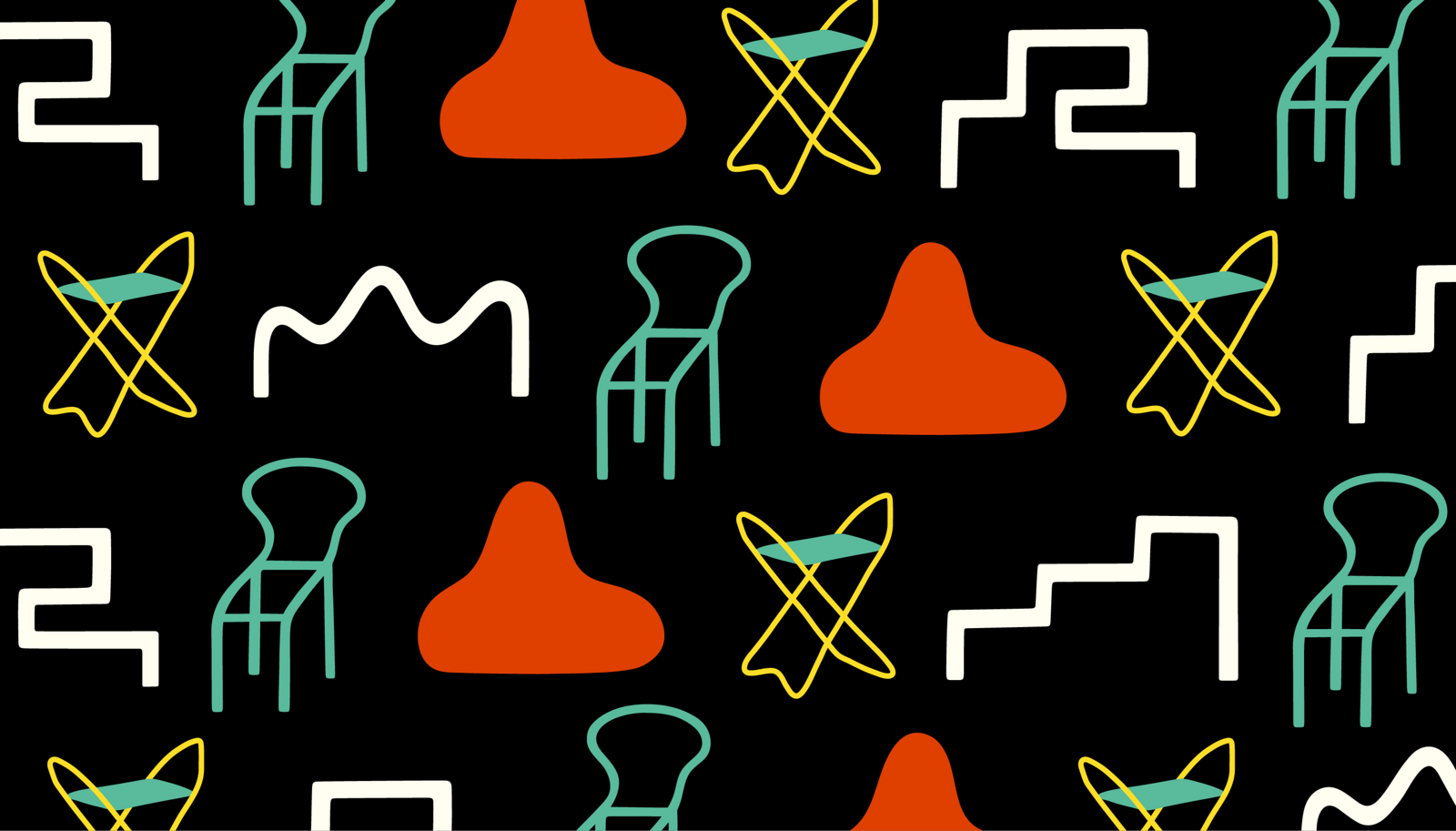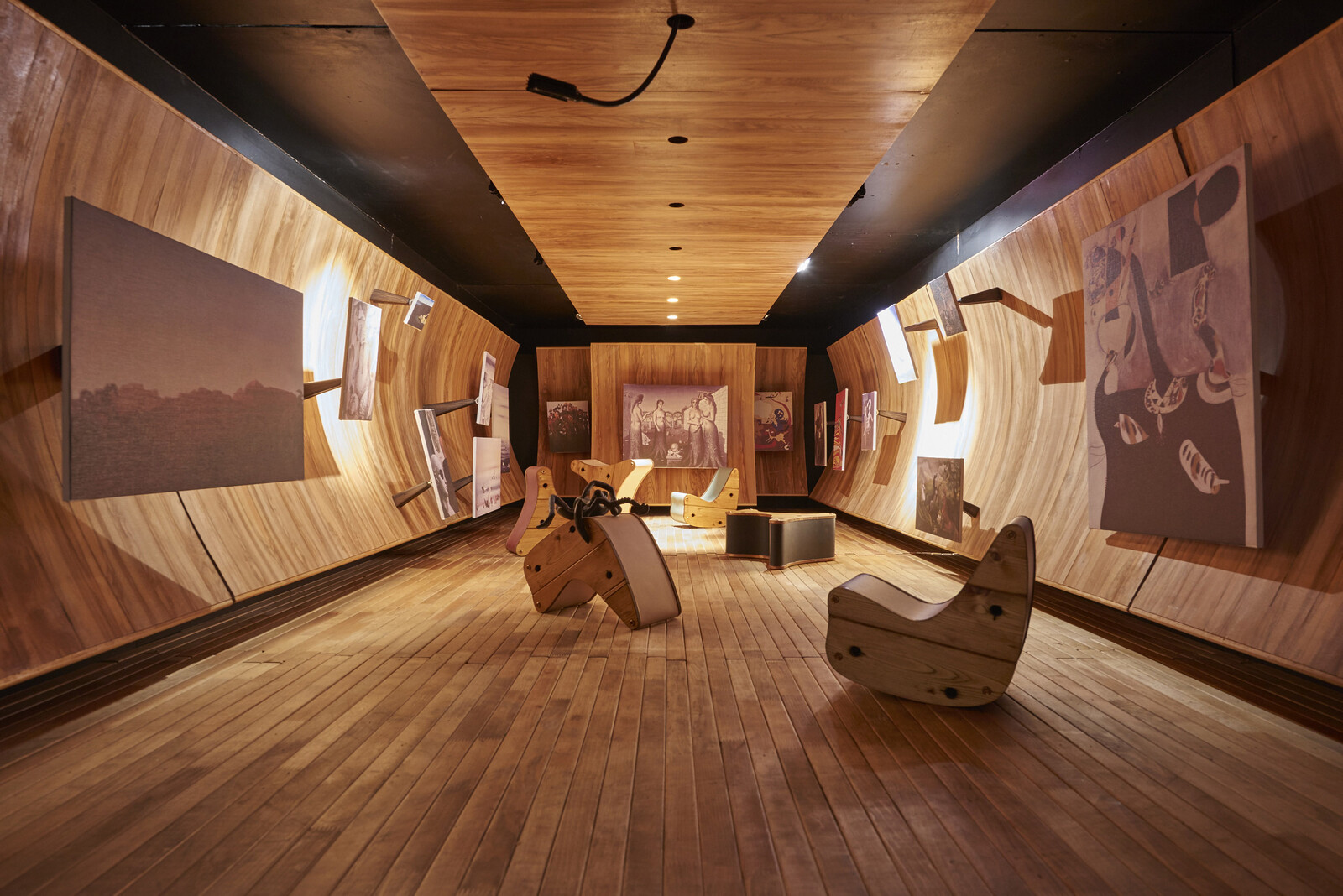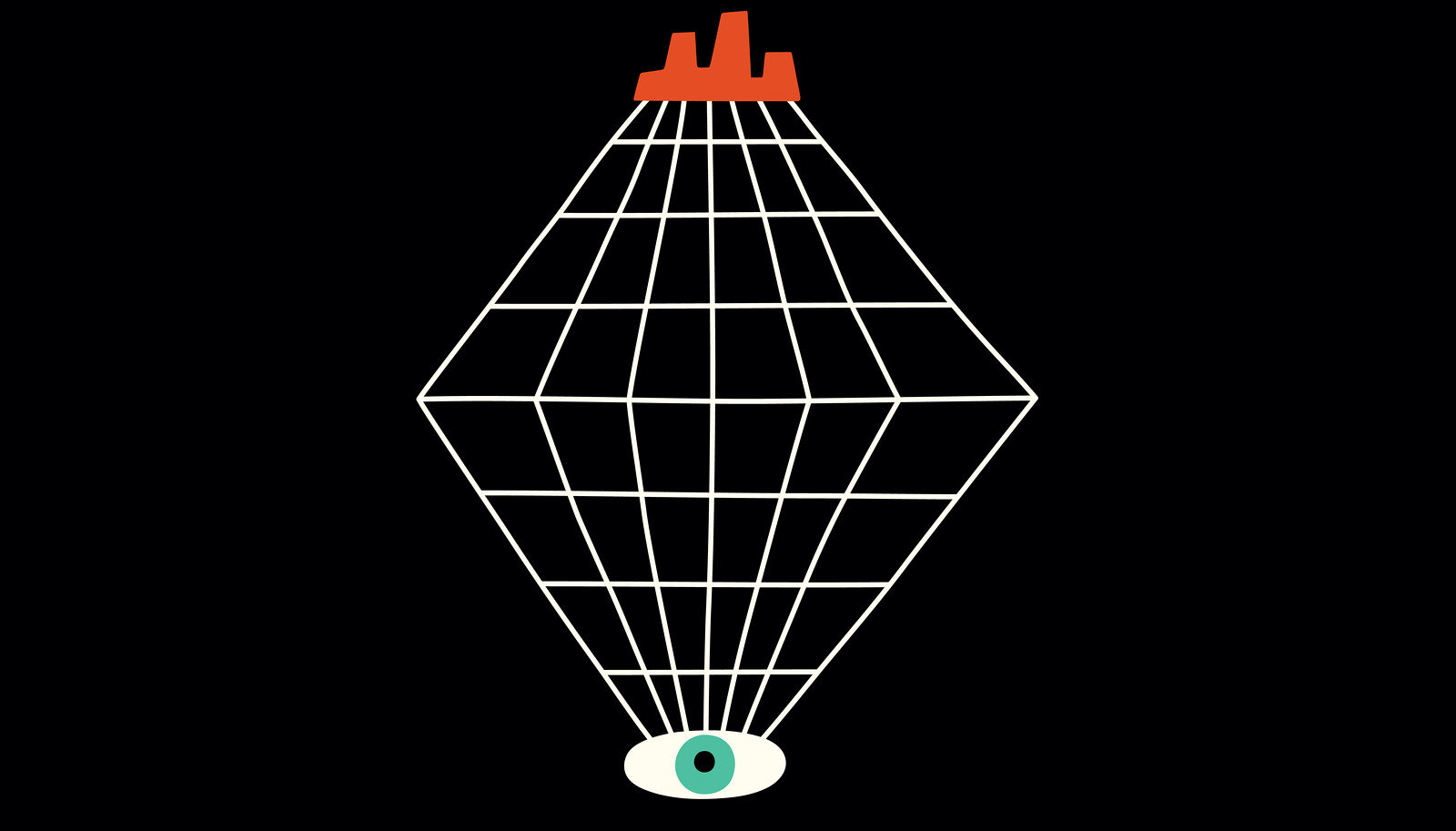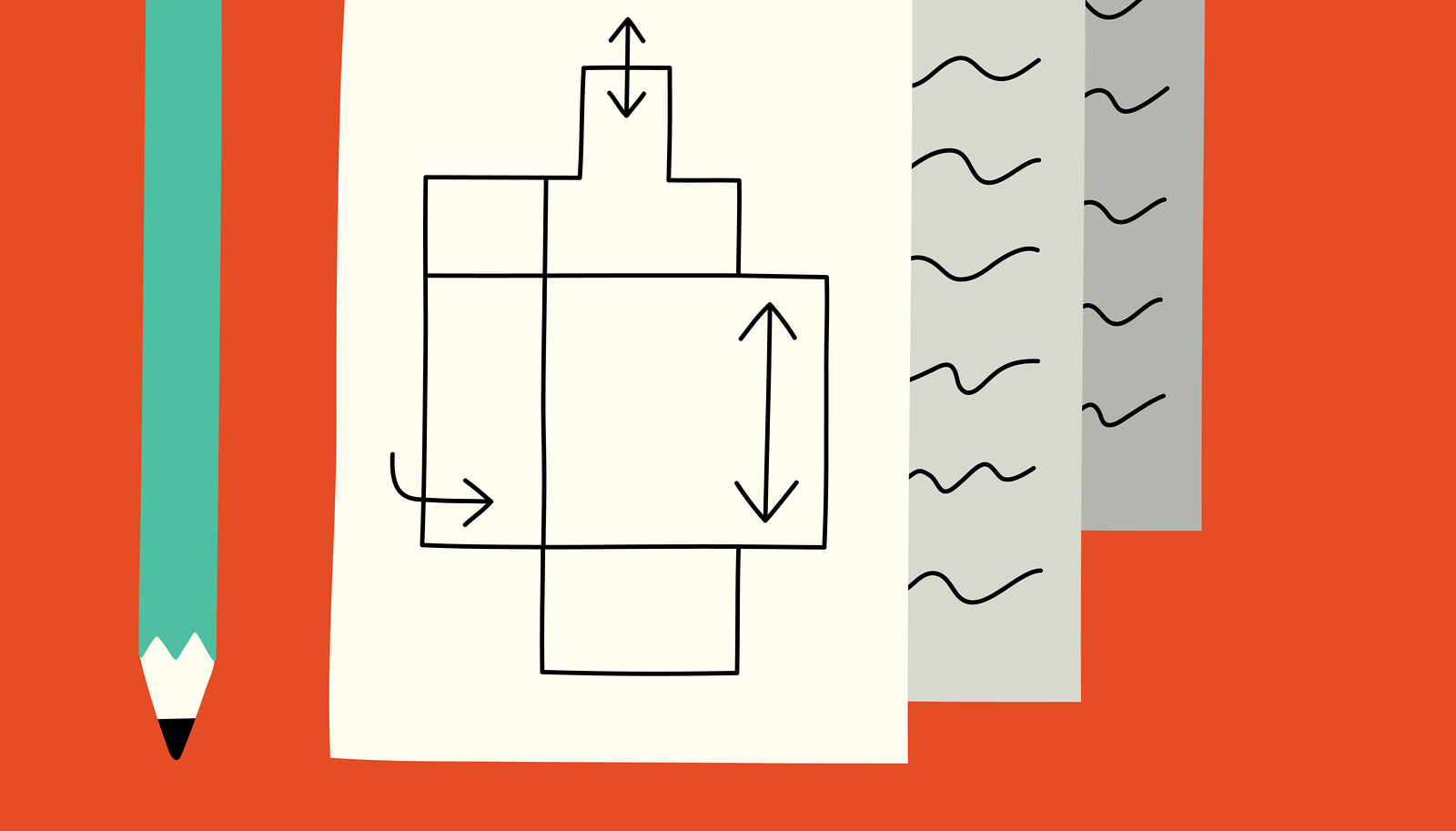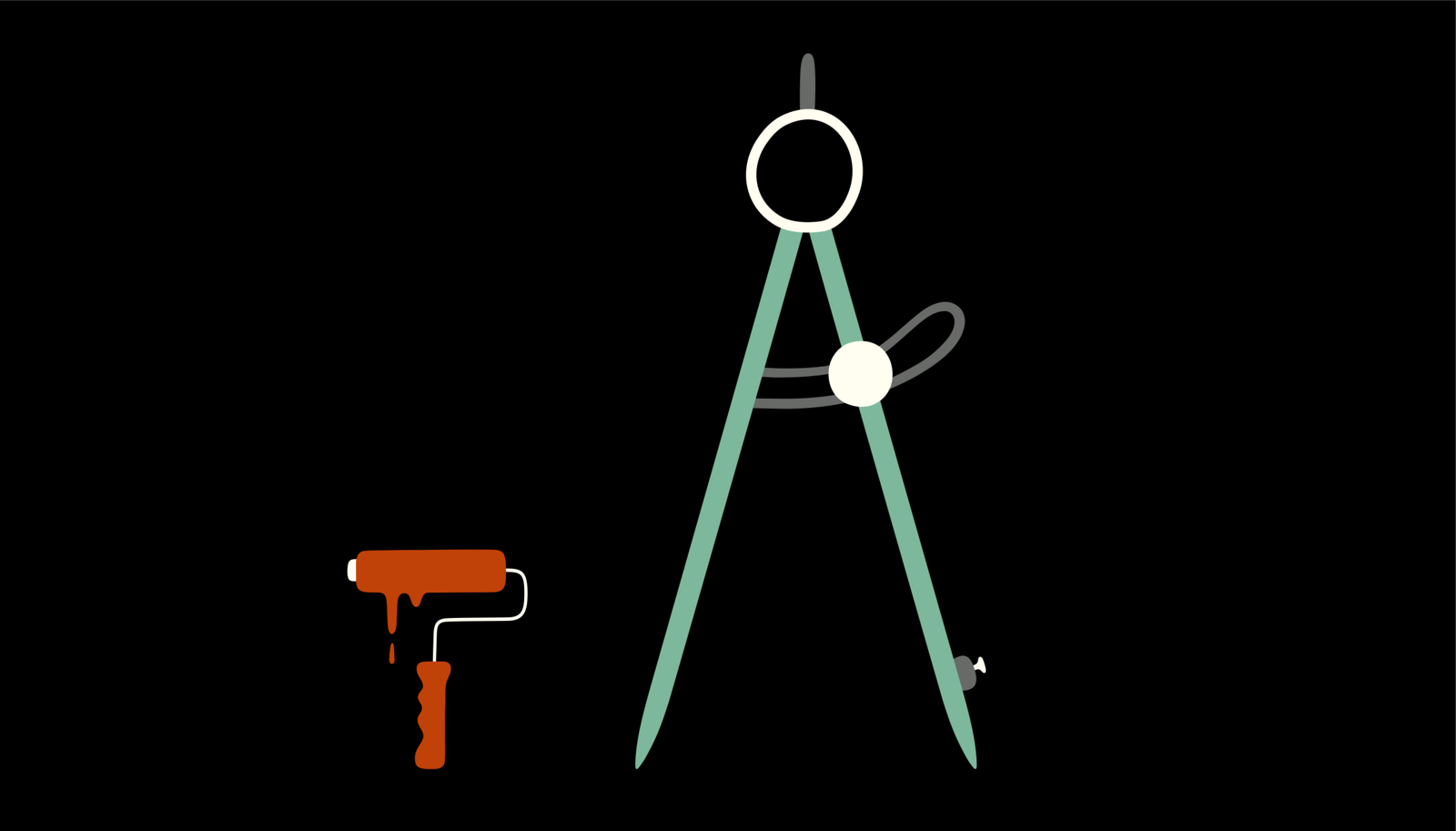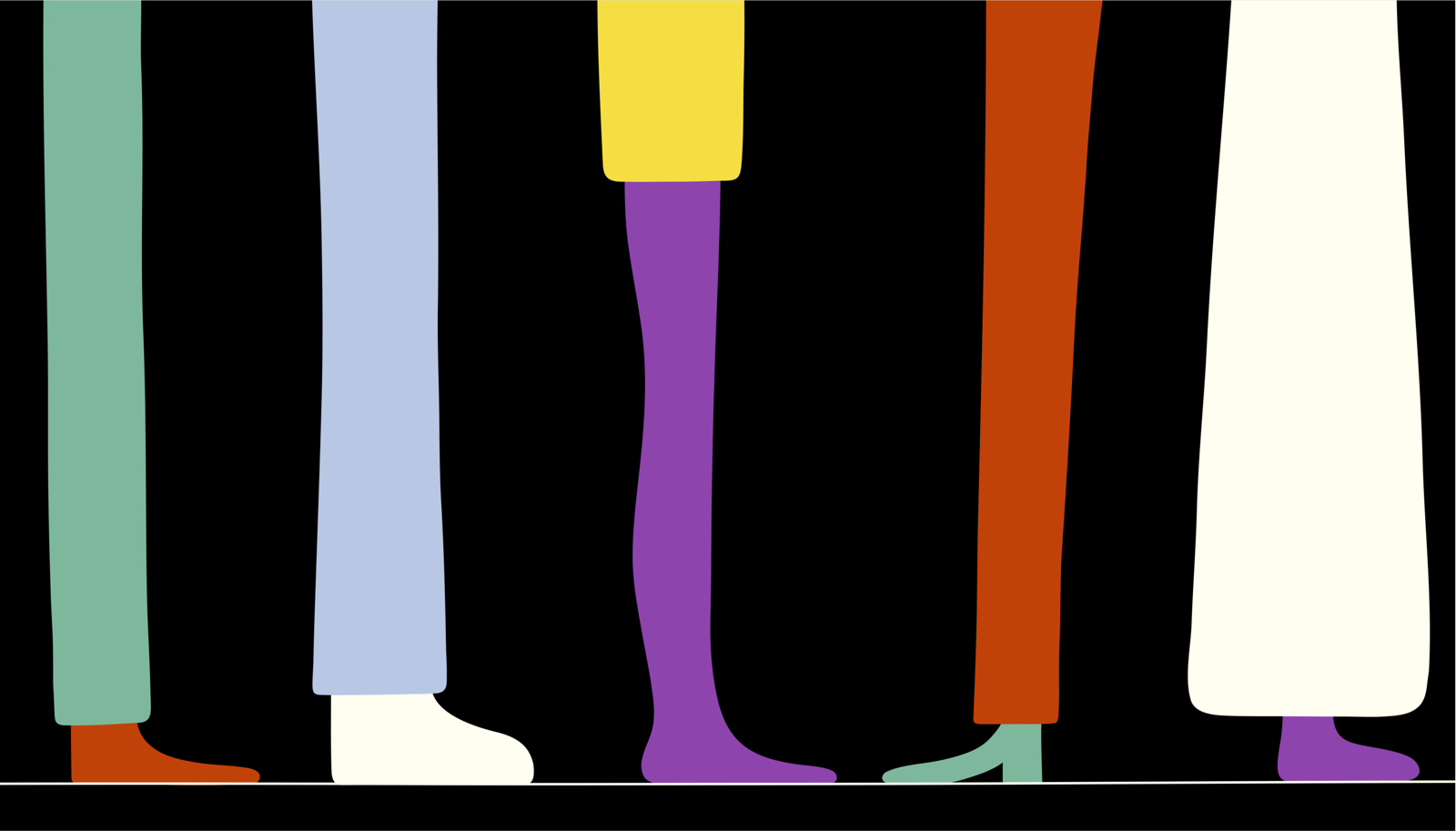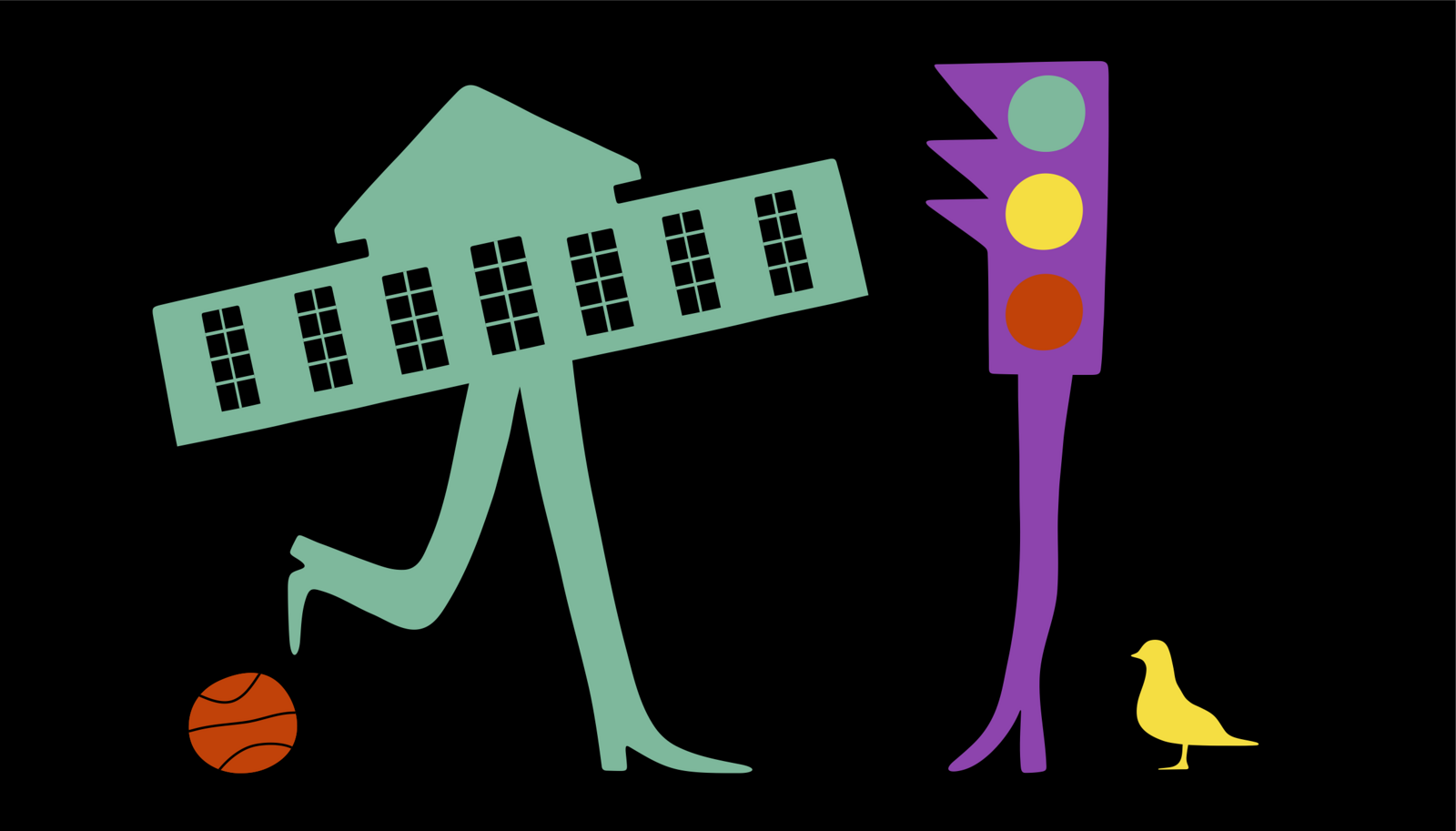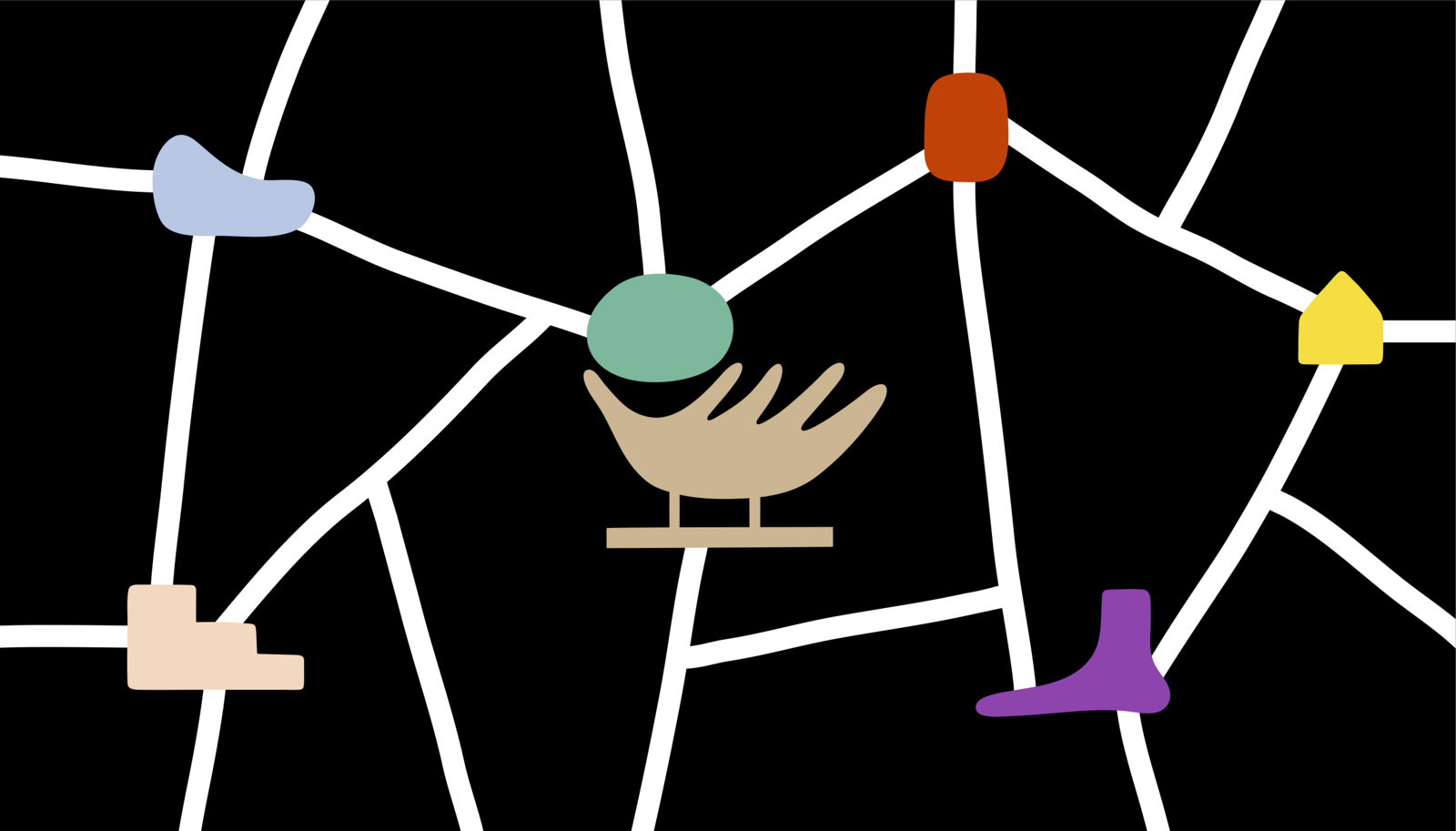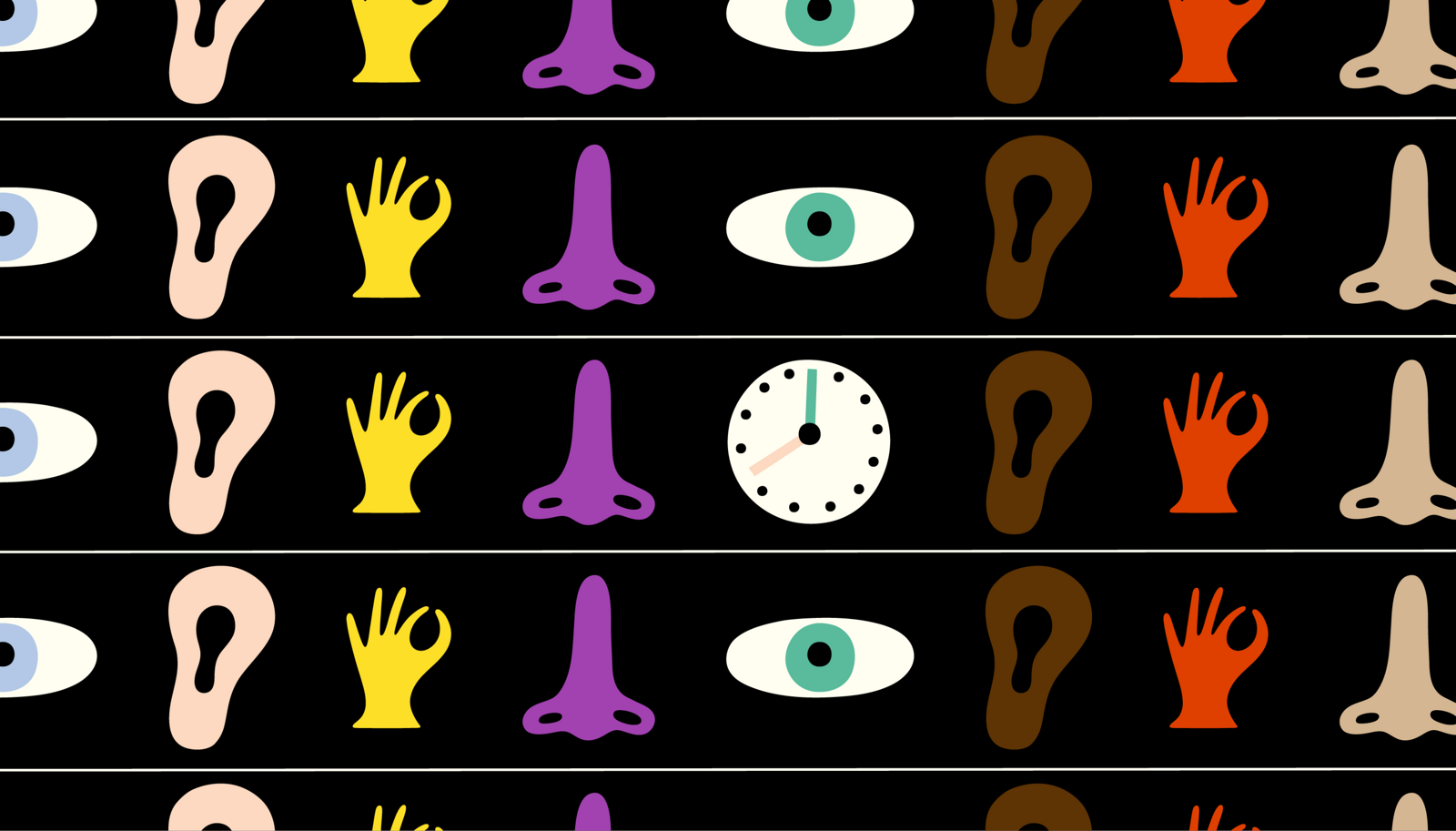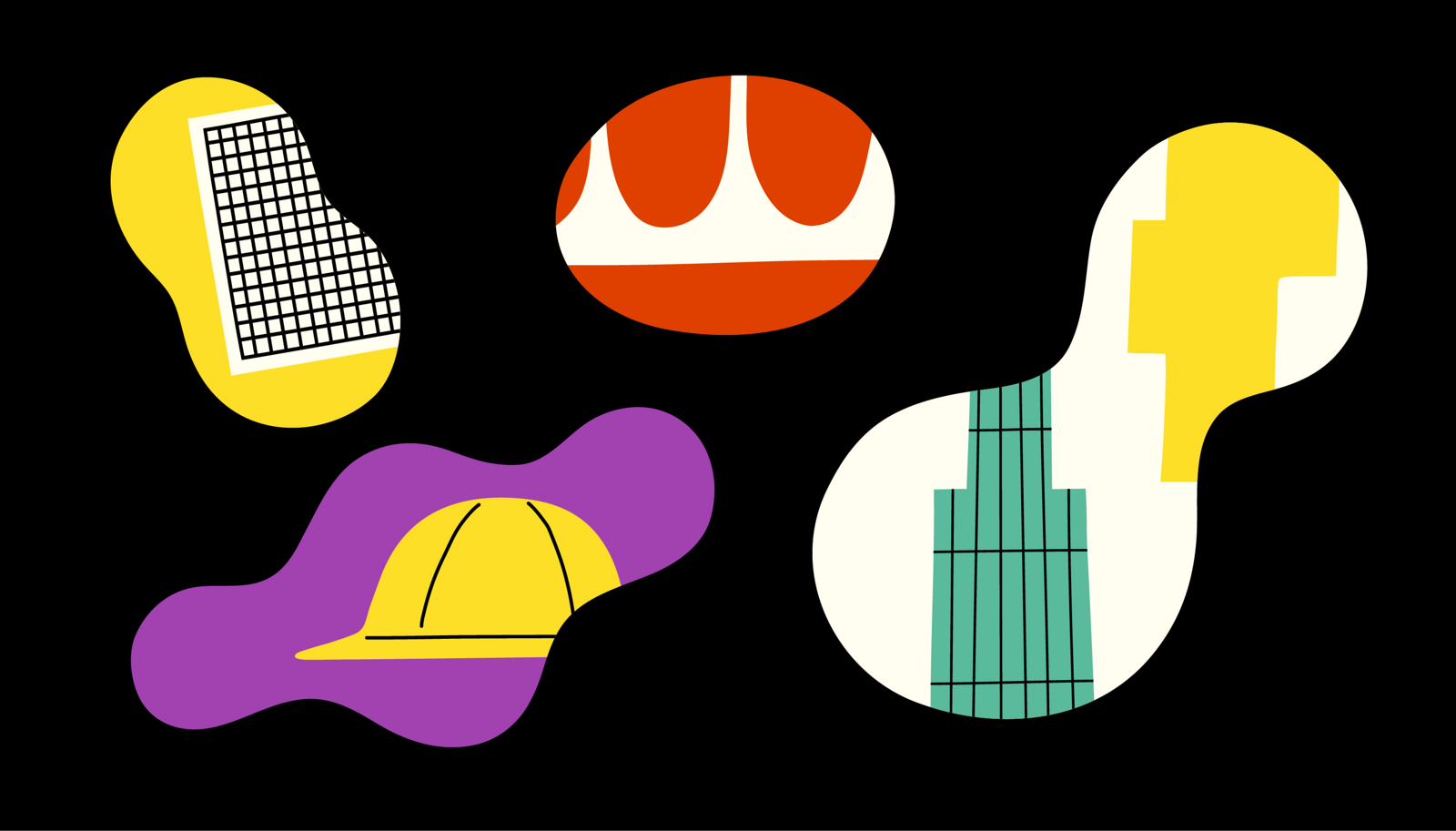You are most likely sitting down while reading this. If not, please look for a place near you where you can take a seat and spend a moment. This text deals with seating in the context of art museums and exhibitions of art. Perhaps you are already at a museum, even in an exhibition? Then I would encourage you to ponder what surrounds you, how you can access that which is on view. Someone who thought a lot about that was the architect, designer, artist, and curator Frederick Kiesler. Made of wood and colored linoleum, his 1942 “Correalist Furniture” can function as a rocker or a bench. Or as a podium. Or a chair, a painting rack, and a bench, all in one, depending on which way it is turned.
Kiesler originally designed his curvy furniture for Peggy Guggenheim’s museum-cum-gallery Art of This Century and its Surrealist Gallery, which he also designed. Paintings by the likes of Picasso, Max Ernst, and Salvador Dali were liberated from their frames and placed on wooden arms that stuck out from the gallery’s bent wooden walls, allowing the canvases to be visually inspected from different angles. Kiesler’s multipurpose furniture pieces were also in use in the adjacent Abstract Gallery, where the walls were covered with blue fabric stretched like a sail and paintings by Kandinsky, Mondrian, and Leger were attached to metal rods running from floor to ceiling. In this context, the Correalist furniture also became abstract sculptures in their own right.1
Kiesler was obsessed with methods to maximize the encounter between an artwork and a viewer. A firm believer in the power of art, he wanted to enhance the experience of the art on view—by changing and twisting their presentation and the ways in which a visitor could get up close and personal with individual works. Fortunately, he was good friends with the artists themselves, who gave their permission for him to test out unorthodox experiments of display. Like in the Surrealist Gallery, where he choreographed lights to switch on and off and added a soundtrack of a roaring train, Kiesler constructed atmospheric installations that sought to unify visitors’ impressions as an experience. He was convinced that the experience of art is not only or even primarily about the eye, but an activation of the entire body. Encountering art demanded a visceral experience; thought and emotion should wander hand in hand. Each art work deserved special attention at the same time as it formed part of an entirety, co-existing with other works.
Kiesler understood something fundamental about exhibitions, and how to make the experience of them as rich and dense as possible. One technique lies in the combination of focusing on individual works, allowing each of them the best possible presentation, and simultaneously seeing them in relation to one another within a distinct environment. The invitation to sit down was key to Kiesler’s understanding of this. Today, almost eighty years down the line, we are expected to hang out in exhibitions, rather than stand and stare. While there has been a “loungeification” in culture, the opportunity to sit down in an exhibition remains an exception rather than a rule.
Kiesler pioneered integrating seating into his art, but he was not the first to think about seats in exhibitions. Museum benches seem to have been first introduced in the nineteenth century; prior to that they were largely limited to copyists, documented while sitting down in the galleries of public museums. The nineteenth century saw a number of different types of seating enter museums, but the majority being large, dark, ornamented, and upholstered benches intended to be occupied by several people simultaneously. By the turn of the century, these bulkier furniture elements—often circular in shape and augmented with prominent backrests—were replaced by lighter and brighter designs. The Venice Art Biennale of 1910, for instance, hosted a solo exhibition of Gustav Klimt, in which works were attached to white walls with neat rattan armchairs strewn around the space. They resembled domestic furniture, a trait that rhymed with a more general trend of the time for intimacy—a tactic also cultivated in commercial galleries, which at the time tended to be housed in apartments with domestic furniture.
Charlotte Klonk traced how the display of art in national museums across Europe have shifted.2 Focusing on every aspect—from the selection of exhibits, wall color, and lighting to the height and density of the art works—she argues that different contexts and periods have developed different models of spectatorship, which in turn have been influenced by their specific political, commercial, and scientific ideals. The attitude to the body of the visitors has shifted too, from ensuring that the museum-goer would not spit indoors to how they could move within the galleries, and perhaps even sit down for a moment.
In the 1930s, the fledgling Museum of Modern Art (MoMA) in New York City began to favor a linear trajectory for its visitors, planning their route in such a way that each person was expected to experience one work at a time. It functioned almost like a conveyor belt, the visitors moving in one direction past a sequence of paintings installed on a line. Klonk describes this as “the consumerist spectatorship model,” where visitors are meant to experience works, and at the end of the route, are confronted with the museum’s shop. I have seen very few benches or other forms of seating in photographs of MoMA exhibitions from this period.
Around the same time, a “collectivist spectatorship model” was taking shape among the Constructivists in the Soviet Union. Rather than advocating for an undeviating path from “A” to “B” and based the notion of an individual observing one work at a time, the collectivist spectatorship model allowed for multiple spatial trajectories and a variety of angles from which to approach sculptures and paintings. Taking into consideration the fact that a number of visitors could be together in the space and share the experience, the artworks were displayed in such a way that a sense of cohabitation was foregrounded and enhanced. Seating was essential to its libraries and reading rooms, and it was introduced as part of exhibitions as well. Simple chairs can be found in a number of photographs from exhibitions in the Soviet Union of the 1920s and 1930s.
While long term displays at museums such as Vienna’s Kunsthistorisches Museum and the Hermitage in St. Petersburg are more generous with seating today, temporary exhibitions, regardless where they are staged, are less forgiving. Museums such as these tend to stick to their old gallery seats, sometimes ones which appear to hail from the nineteenth century. As if expected to require a different mode of viewing, where the flow of visitors moving through the galleries must not be broken, temporary exhibitions in art museums tend to be devoid of seating. For the artist and architect Celine Condorelli, however, seating in exhibitions needs to be taken seriously. Seating belongs to the essentials of life; it facilitates something beyond themselves. Much like Kiesler, Condorelli has created a number of artworks that take the form of seats to be used in exhibitions of contemporary art, overcoming in each instance genre hierarchies between usable objects and art.
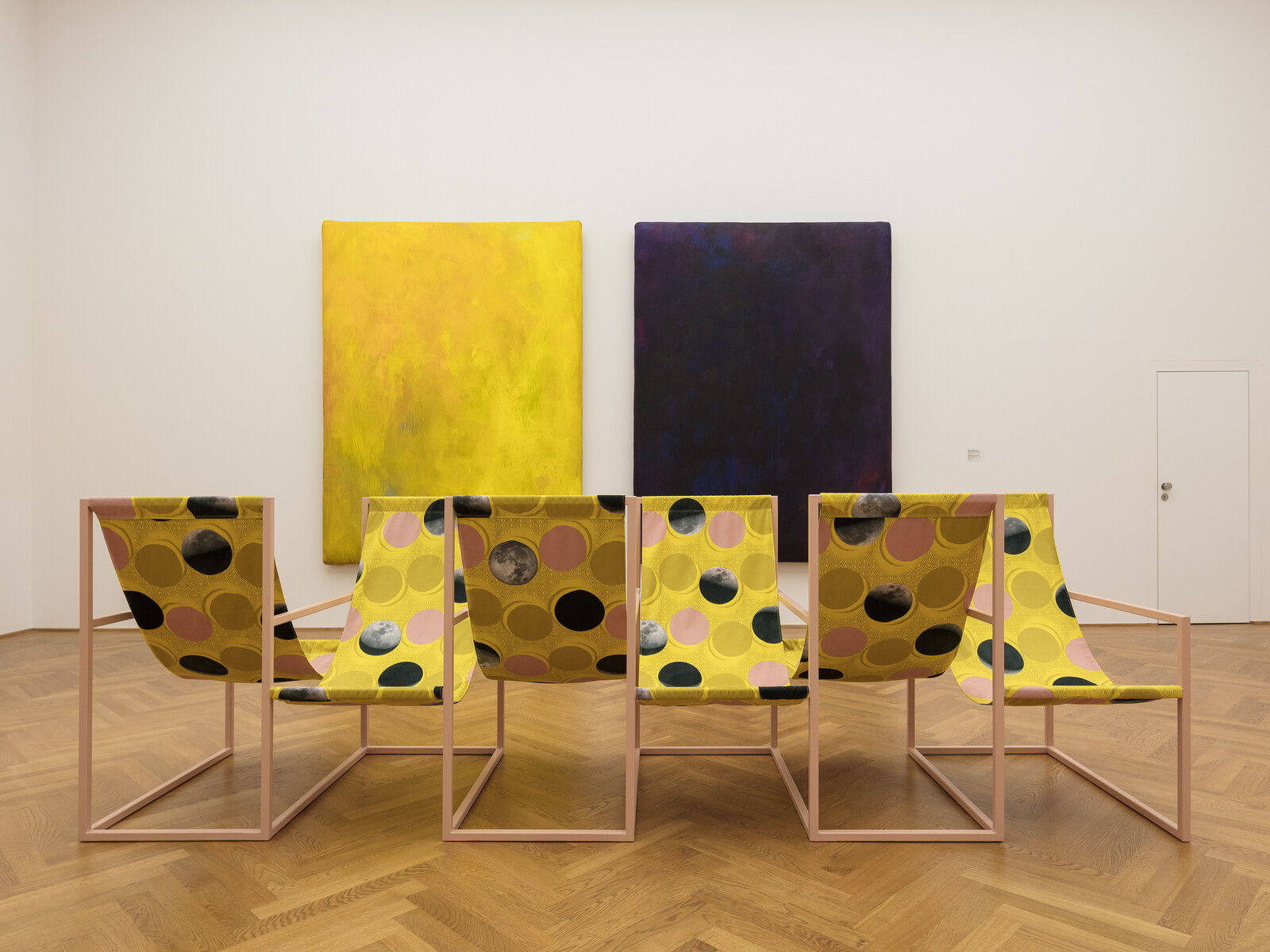
Celine Condorelli, Spatial Composition 12, 2019. Installation view, Albertinum, Dresden State Art Collections. © SKD, photo by Klemens Renner.
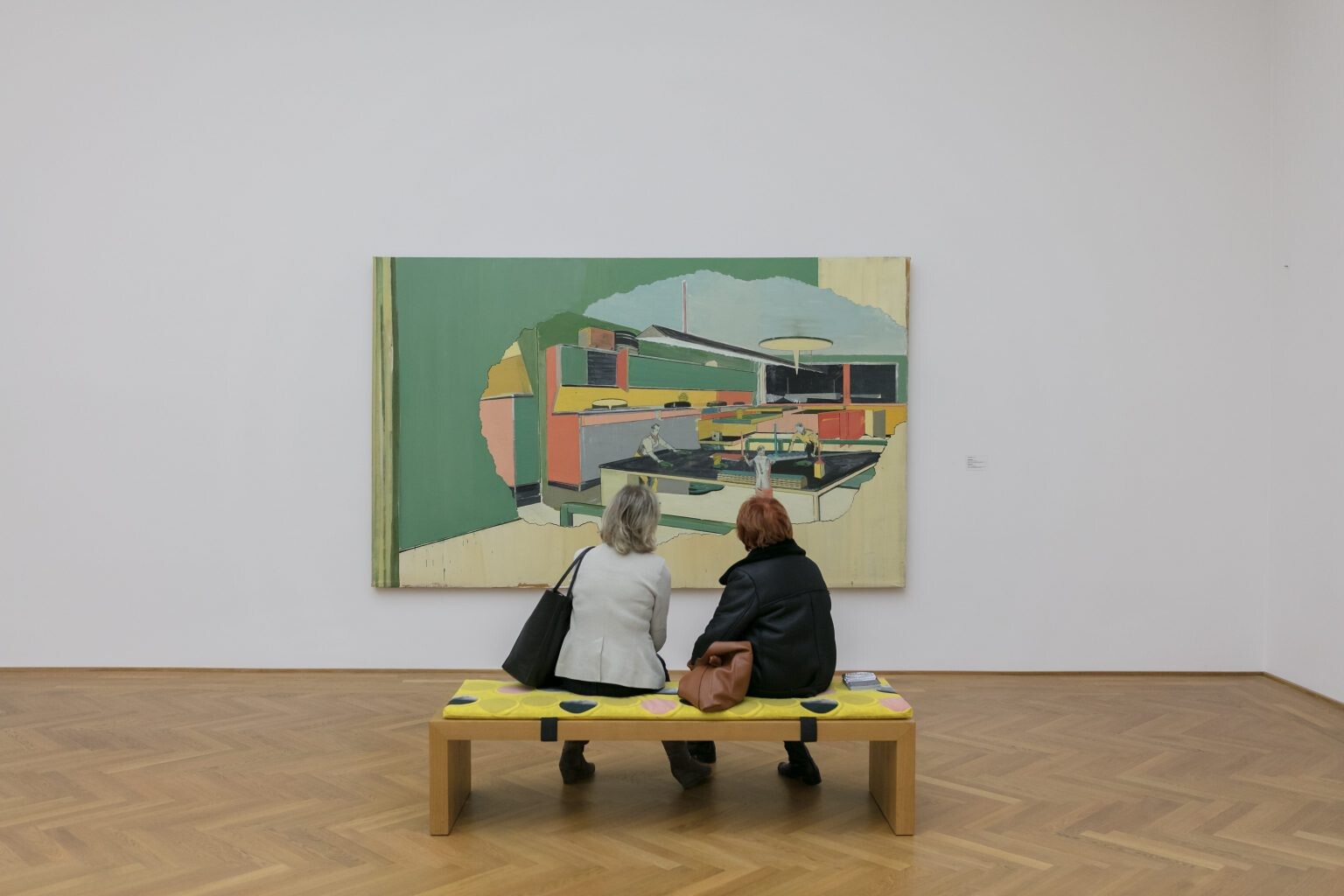
Celine Condorelli, Spatial Composition 12, 2019. Installation view, Albertinum, Dresden State Art Collections. © SKD, photo by Klemens Renner.
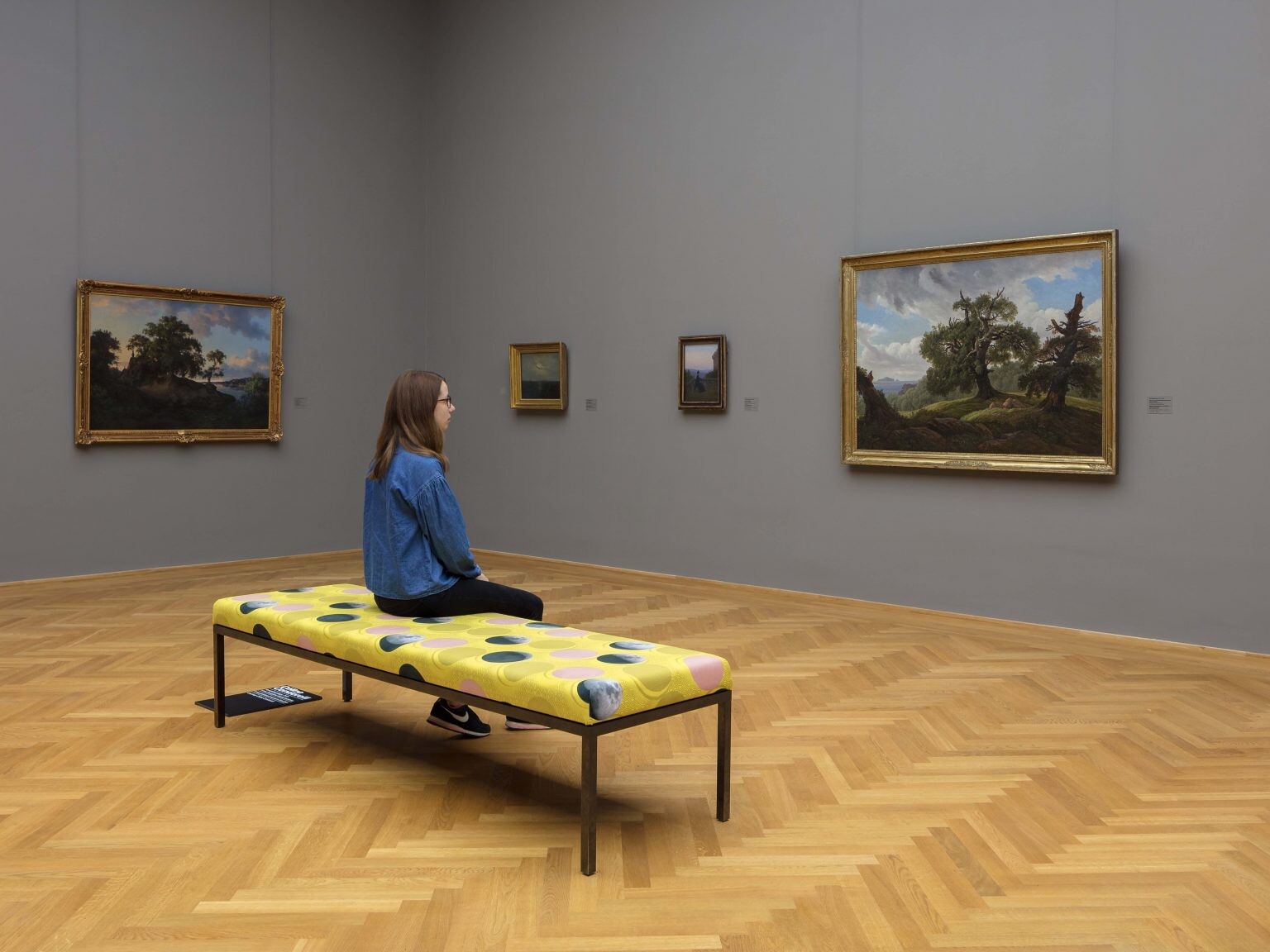
Celine Condorelli, Spatial Composition 12, 2019. Installation view, Albertinum, Dresden State Art Collections. © SKD, photo by Klemens Renner.
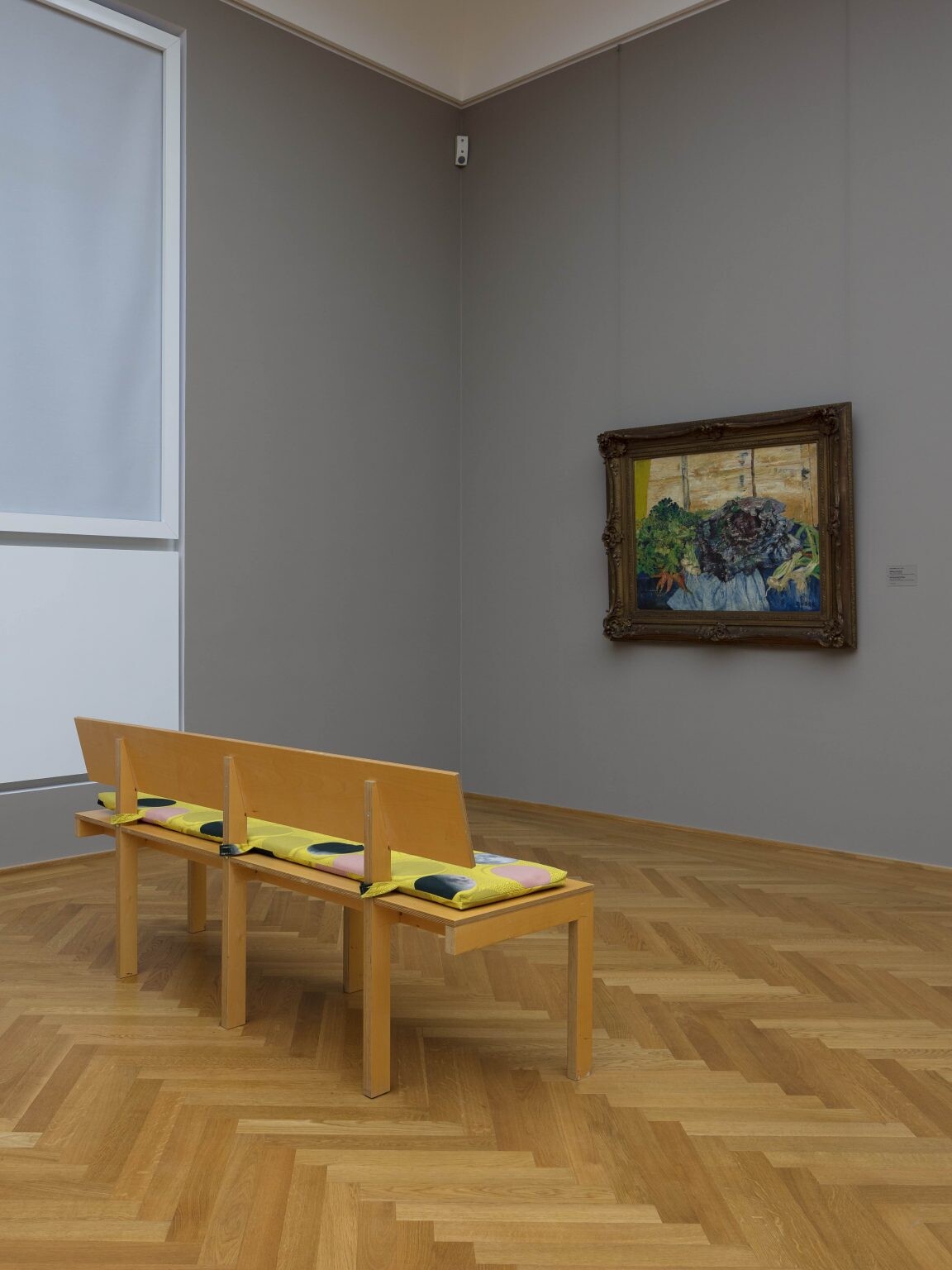
Celine Condorelli, Spatial Composition 12, 2019. Installation view, Albertinum, Dresden State Art Collections. © SKD, photo by Klemens Renner.
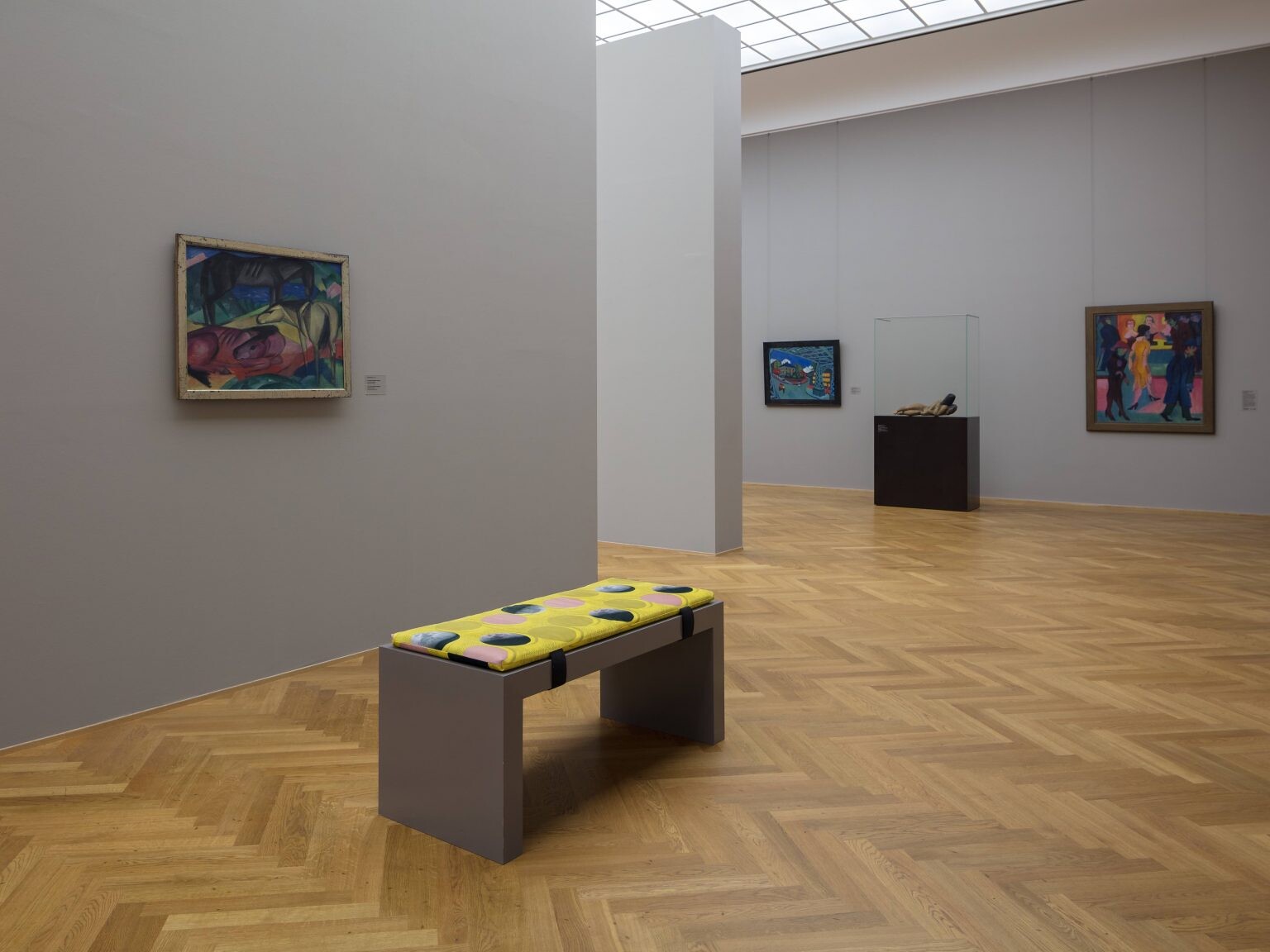
Celine Condorelli, Spatial Composition 12, 2019. Installation view, Albertinum, Dresden State Art Collections. © SKD, photo by Klemens Renner.
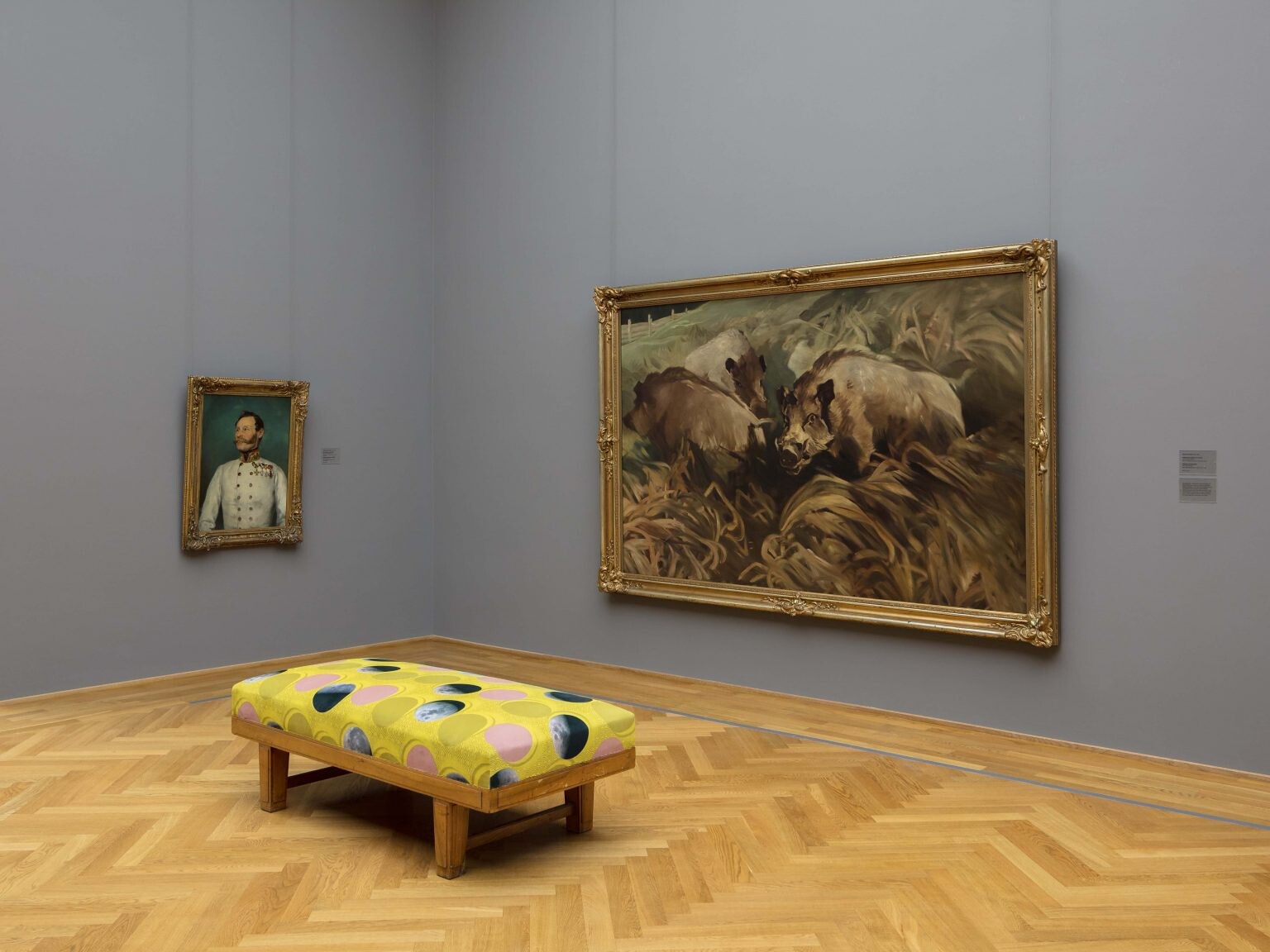
Celine Condorelli, Spatial Composition 12, 2019. Installation view, Albertinum, Dresden State Art Collections. © SKD, photo by Klemens Renner.
Celine Condorelli, Spatial Composition 12, 2019. Installation view, Albertinum, Dresden State Art Collections. © SKD, photo by Klemens Renner.
For a recent project at the Albertinum in Dresden, Condorelli researched the museum’s post-war seating, uncovering old examples held in storage as well as in the homes of staff members. Six types were selected and renovated, provided with new upholstery and cushions made from colorful fabrics with a bold circular pattern. The pink, yellow, and grey patterns were inspired by the colors of the museum’s walls and African wax prints, citing transcultural pollinations, global production, and multi-directional trading cycles in the context of an institution whose collection is dominated by works from the Western canon. Her project also included a new type of seating: a row of attached deck chairs facing different directions—a type of seating which is not typically associated with museums but are largely affiliated with leisure, dislocating the distinction between public and private, interior and exterior.
Since the 1990s there has been a steady stream of stools, chairs, carpets, pillows, benches, and beanbags in (primarily smaller) exhibitions of contemporary art, from the likes of Hito Steyerl, Ai Weiwei, and Franz West to Marie-Louise Ekman, Apolonija Sustersic, Michael Beutler, and Christian Nyampeta. We should also not overlook an entirely different contribution to the phenomenon of “seating in museums and exhibitions of contemporary art”: the flatpack multinational IKEA, whose modest and affordable seating is used in exhibitions and other institutional spaces around the world, from Tehran and Copenhagen to Nizhny Novgorod, Zagreb, Tokyo, and New York.
When I happen upon seating, it facilitates my experience: how I look at a specific work, spend time physically close to another, watch fellow visitors, or simply check my phone. I appreciate it even more if I have a handout to read. Beanbags are my preference for the opportunity to sink into one, to recline and rest for a moment, to even close my eyes and doze off. Seating helps me to both sharpen my senses and unwind among the experience of art, to be embedded and allowed to tune in and out and in again. It facilitates contemplation, an underused faculty within contemporary art. Such hospitality toward bodies and minds is ripe for exploration. I am still waiting for a legitimate opportunity to take a nap in an exhibition, on some kind of purpose-made seating.
Having seating as part of projects, galleries, or exhibitions for the sake of it is abundant. Yet seating should always add to or facilitate something that is not already there. It needs to go beyond itself to generate new synergies. In the same way that the act of collaboration should lead to something which could not have been achieved by working on your own, seating for the sake of seating becomes no more than a gesture, self-serving through the lens of social and curatorial formalism.3 It should add something to the visit, to the experience in and of itself, facilitating an encounter with art and making the museum visit rewarding. Certainly, a successful visit to an exhibition is not only conditioned by whether there is seating or not. The material presented, and how it is presented lay the foundation. But sometimes, elements of a spa experience, a stopover at a library, a glimpse into a sanctuary, or a walk in the park can contribute to the successful visit.
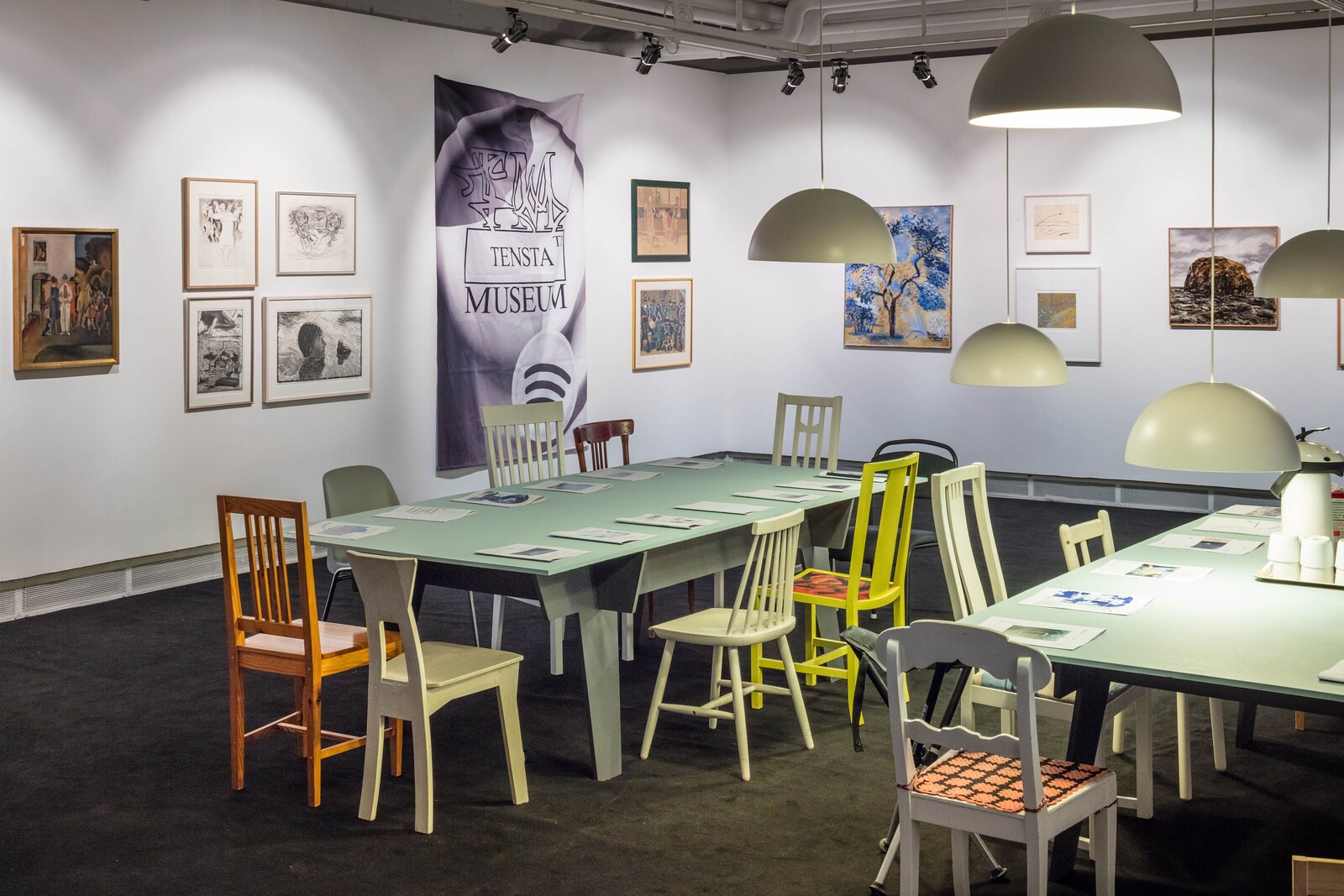
Christian Nyampeta, Tensta konsthall Classroom, 2018. Photo by Jean-Baptiste Beranger.
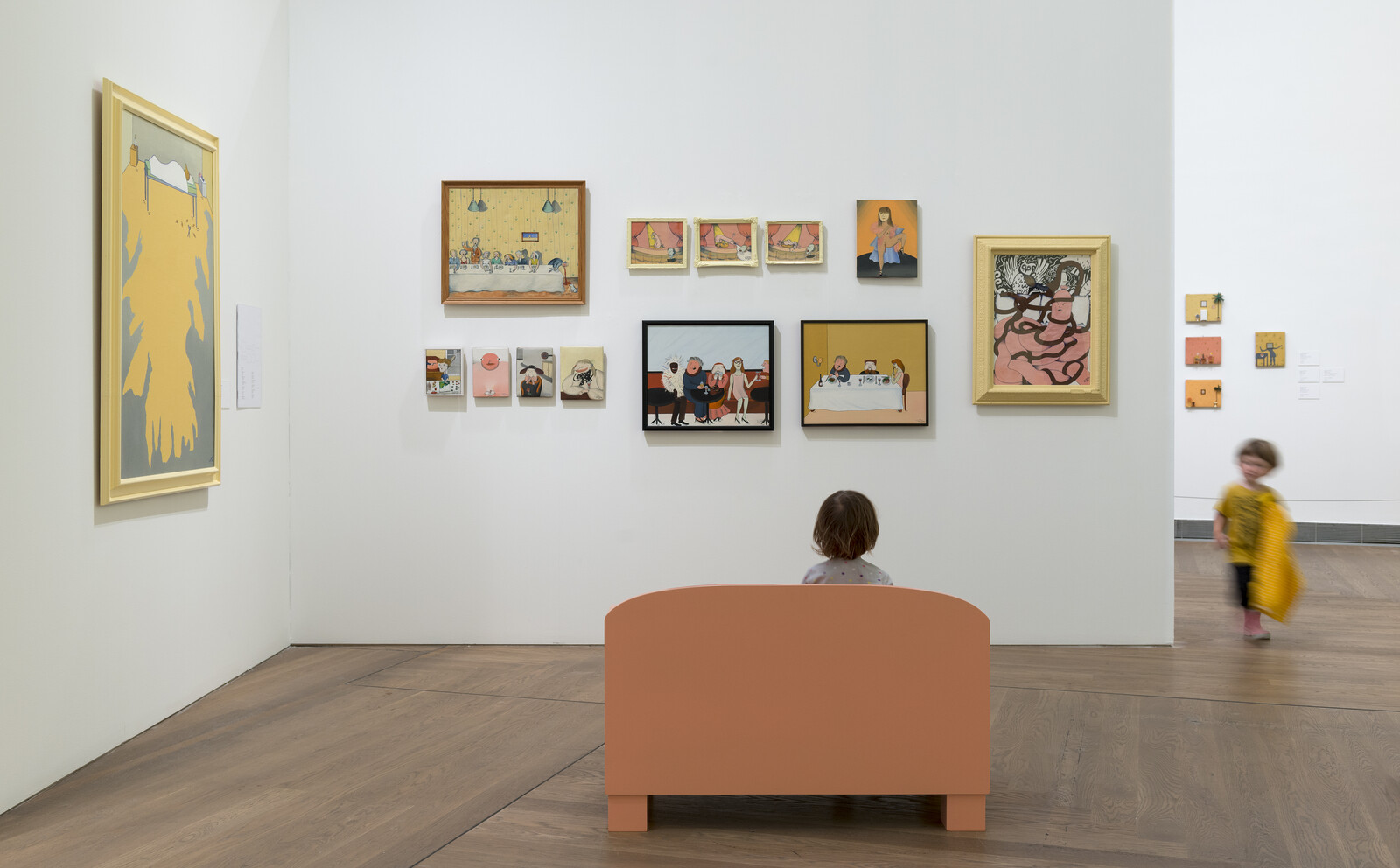
Marie-Louise Ekman, 2017, installation view, Moderna Museet, Stockholm. © Åsa Lundén/Moderna Museet.
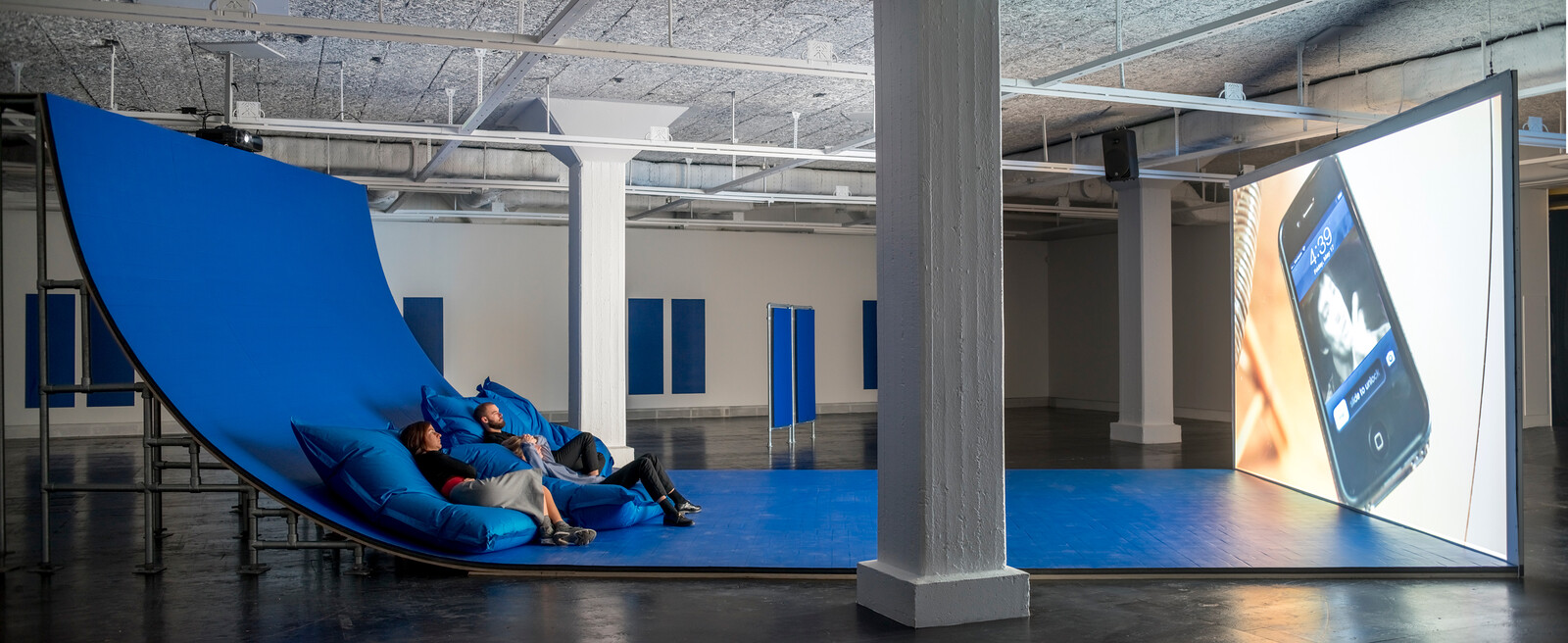
Hito Steyerl, Liquidity, Inc., 2014, installation at Tensta Konsthall, 2015. Photo: Jean-Baptiste Béranger.
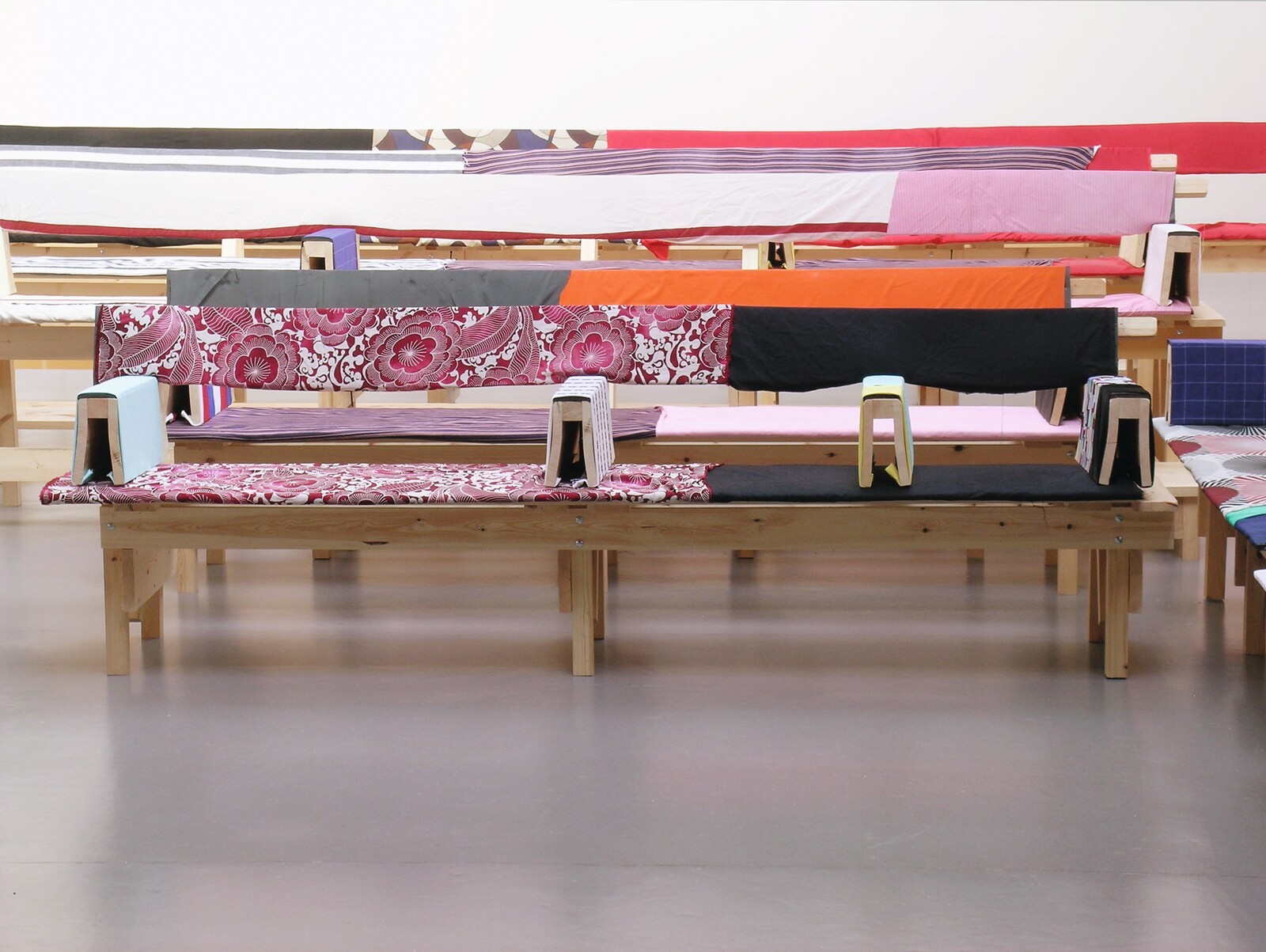
Michael Beutler, IASPIS Bänke, 2005.
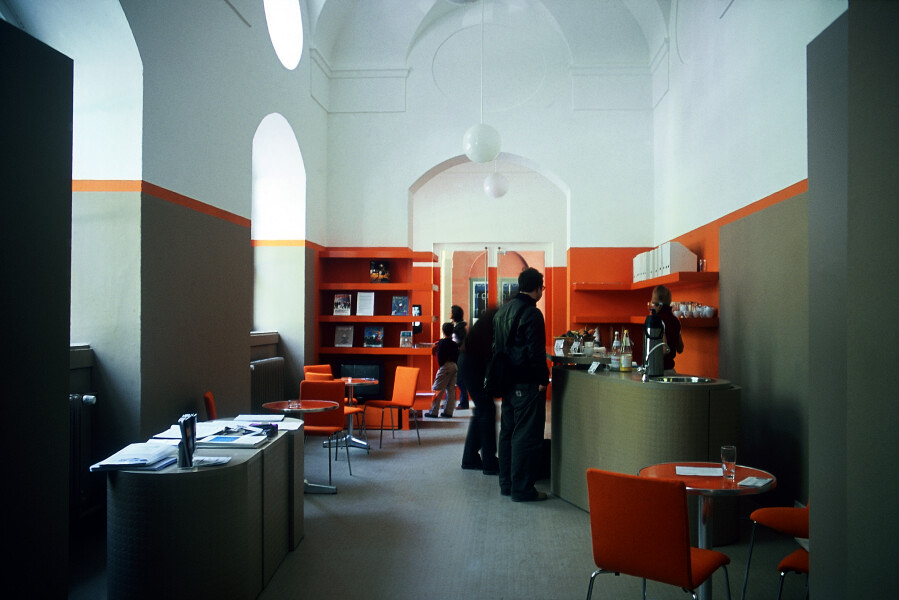
Apolonija Šušteršič, Sputnik Lobby / Eintritt, Kunstverein München, 2002.
Christian Nyampeta, Tensta konsthall Classroom, 2018. Photo by Jean-Baptiste Beranger.
Between 1923 and 1955, art historian Ernst Fischer was director of the Malmö Museum, an encyclopedic institution encompassing art, ethnography, biology, and zoology. During his leadership he promoted a radical and experimental form of museum work. Not only did he spearhead the museum becoming a refugee shelter in May of 1945 (after the city’s public infrastructure had quickly filled up with released concentration camp prisoners), but he also promoted a vitalist curatorial methodology, in which the ultimate goal was to make the museum “come alive.” According to a vitalist worldview, plants and animals, as well as art and other objects in exhibitions have agency. They are active; they do something. The challenge for those who work in the museum, then, is to create the context to allow them do whatever it is they do.
For Fischer and the team at Malmö Museum this meant that if the objects are presented in the right way, with concise information in various media, they will evoke both thought and a sense of pleasure. If victorious, they can even intensify a feeling of being alive. A mix of cognitive and affective methods were used, designed to create contexts and to make the material accessible and meaningful. For instance: a crab next to a lobster is less compelling in terms of evolution than in conveying the fact that the lobster changes color after it dies, which in turn can stir an interest in biochemistry. In other words, the exhibits should neither be fenced in nor be subjected to “fun events,” the kind which many museums today feel it is necessary to stage in order to attract and please the visitors.
In a text written about Malmö Museum during this period, the art critic Lars-Erik Hjertström Lappalainen likens this to how tardigrades (also known as water bears or moss piglets) can be taken into a state where they show almost no sign of life.[figure Lars-Erik Hjertström Lappalainen, “The Museum’s Transformation after Death.” In: Migration: Traces in an Art Collection, Maria Lind and Cecilia Widenheim, Eds. (Sternberg Press, 2020).] These tiny creatures, however, can be awakened by a favorable environment. In short, according to the Malmö methodology, the purpose of a museum is less to promote or evoke an awareness of art, architecture, and design than it is to promote life. To stir souls. As opposed to merely generating knowledge, this stirring of souls should support culture in its ultimate function in society: namely, to facilitate an “intensification” (förhöjning in Swedish) of life. Sensitively designed and placed seating is likely to contribute to that.
Friedrich Kiesler: Life Visions, Christoph Thun-Hohenstein, Dieter Bogner, Maria Lind, Bärbel Vischer, eds. (Birkhäuser, 2016).
Charlotte Klonk, Spaces of Experience: Art Gallery Interiors from 1800 to 2000 (New Haven: Yale University Press, 2009).
To paraphrase the curatorial collective What, How & for Whom/WHW.
Solicited: Proposals is a project initiated by ArkDes and e-flux Architecture.
